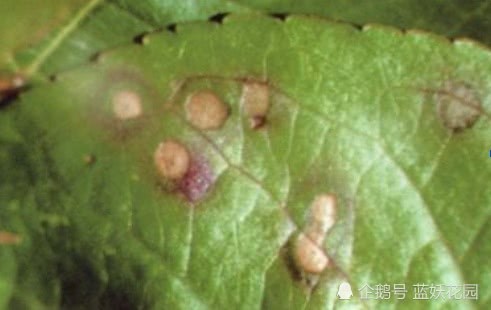Does the peony grow very thin? Be careful if you get this disease.

20. The peony flowers are very thin. Be careful if you get this disease!
This is an excerpt from the original column "Peony Culture" written by the Blue Devil.
Yesterday, the blue demon introduced the four common diseases of peonies. In addition to the four diseases mentioned yesterday, there are also some diseases that are easy to get from peonies. Let's continue to introduce them today.
1. White star disease
White star disease, also known as ring spot disease, is more common in peony flowers. In the early stage of the disease, the disease class on the leaves showed a network or nearly round, about 4-10mm in diameter, and the number was relatively large, light brown to grayish white, margin brown. On the other hand, there is an obvious gray-black mildew in the center of the concentric ring disease class, which is the sporophyte of the pathogen.
Ring spot disease is mainly prevented. Spraying stone-sulfur mixture before peony germination in early spring can effectively reduce the incidence. Spraying mancozeb at the initial stage of the disease can be cured by continuous spraying 2-3i once a week.
2. Withered branch disease
The pathogen of withered branch disease mainly invades from the wound, there are many wounds, and the plants with weak growth are the most likely to occur.
The withered branch disease mainly infects the stem, branches and other parts of the peony. When the stem is sick, it is a light brown disease class, which gradually expands into a reddish brown oval disease class. The disease class can circle around the stem and make the branches above the disease spot die quickly.
Prevention of withered branch disease should be given priority to, usually pay attention to the application of phosphorus and potassium fertilizer to enhance the resistance of plants, while reducing the occurrence of wounds, once the disease occurs, carbendazim, mancozeb and other solutions are applied to spray the whole plant, and the infected site is treated with fungicides.
3. Brown spot
Brown spot is very similar to black spot, which is the most harmful in the rainy season with high temperature and humidity. it is a fungal disease, which starts from the lower leaves and spreads upward gradually, showing round or oval in the initial stage, purple-brown spots in the early stage, black spots in the later stage, and clear boundaries. In severe cases, the disease class can be connected into pieces, resulting in withered and yellow leaves and affecting flowering.
To prevent brown spot, carbendazim can be sprayed before sprouting in early spring, and mancozeb or carbendazim should be sprayed in time after the disease, once every 5-7 days, 2-3 times continuously.
4. Root knot nematode disease
Compared with other diseases, the treatment of root-knot nematodes is more troublesome.
After the invasion of root-knot nematode, irregular nodules of different sizes will be produced in various parts of fine roots and thick heels, that is, root knot. The initial stage of infection is yellow and white, the appearance is smooth, and after severe infection, it will appear brown and broken and rotten.
Root-knot nematode will cause premature defoliation of peony. When the disease is serious, the peony will lose all its leaves in August. Continuous occurrence can lead to short peony plants, small leaves, small flowers or even no flowering.
Prevention of root-knot nematodes is greater than treatment. If diseased seedlings are found before planting, they should be soaked in 0.1% isomalidophos for 30 minutes or in warm water of 48 ℃-49 ℃ for 30 minutes. The disinfection of the basin soil during the basin can be effectively prevented.
Although the blue demon has shared a lot of knowledge about peony culture, it is inevitable that there will always be some problems in the process of peony culture. starting tomorrow, the blue demon will talk about the ways to deal with common problems in the process of peony culture. Welcome to stay tuned.
If you want to grow flowers with the Blue Monster, please follow my Wechat account: blue Devil Garden (ilanyao) to bid farewell to rookies.
- Prev

Habitat, Painting and Artistic Conception of Chinese Bonsai
The creative process of Chinese bonsai is: first create the "habitat" of natural beauty and life beauty; then further improve the artistic processing to the "painting realm" of artistic beauty; finally achieve the ideal beauty of "artistic conception" through touching the scene, enter the three...
- Next

Orchids can't grow. A lot of people make the same mistake. This kind of plant is hard to grow orchids.
Planting materials play an important role in whether orchids are raised well or not. If the plant material is prepared correctly, the orchid can get twice the result with half the effort; if something goes wrong with the plant material, it is very difficult to feed the orchid, let alone raise it well. What kind of plant is used for orchids? About these good photographers.
Related
- Wuhan Hospital Iron Tree Blooming Result Was Instantly Frightened by the Gardener Master
- Which variety of camellia is the most fragrant and best? Which one do you like best?
- What is the small blue coat, the breeding methods and matters needing attention of the succulent plant
- Dormancy time and maintenance management of succulent plants during dormancy
- Minas succulent how to raise, Minas succulent plant pictures
- What are the varieties of winter succulent plants
- How to raise succulent plants in twelve rolls? let's take a look at some experience of breeding twelve rolls.
- Attention should be paid to water control for succulent plants during dormant period (winter and summer)
- Watering experience of twelve rolls of succulent plants
- Techniques for fertilizing succulent plants. An article will let you know how to fertilize succulent plants.

